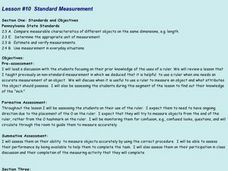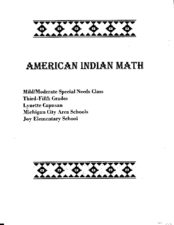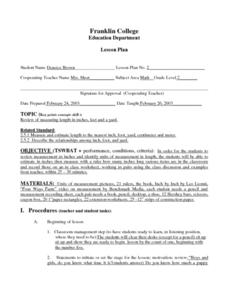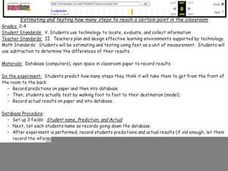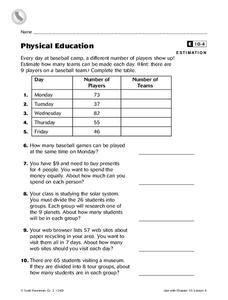Curated OER
ExplorA-Pond: 4th Grade Perimeter Estimation
Your geometers are used to finding the perimeter of a square or rectangle, so give them something different this time! With this lesson, small groups will receive a picture of a shoreline and calculate the perimeter. The website listed...
Curated OER
Lesson #10 Standard Measurement
Learners are introduced to units of measurement found on a ruler as well as what attributes make an object difficult or easier to measure with a ruler. The teacher has various objects placed around the room, and the youngsters practice...
Curated OER
Linear Equations and Functions - Area and Perimeter
Students use information they know to decorate a room at a reasonable cost by comparing the cost of companies for a decorating job. In this cost lesson plan, students take into consideration the area and perimeter of the room.
Curated OER
Boomerang
Students explore the concept of boomerangs. For this boomerang lesson, students throw homemade boomerangs at different angles to record maximum distance and if it returned or not. Students collect their boomerang data then create a...
Curated OER
Circle Graphs
In this circle graphs worksheet, learners solve and complete 8 different problems that include word problems referring to two different circle graphs shown. First, they follow the directions for each problem and complete the table that...
Curated OER
Small Angle Calculations
Students work with circles, angles and estimating angles in the night sky. In this circles and angles lesson, students practice measuring a degree using the circumference of a circle and apply the degree to determine a way to use their...
Curated OER
Mystery Jars: Make Your Own
There are many ways to implement this estimation and counting activity. Young mathematicians fill jars with objects to create "mystery jars." Add difficulty by using smaller objects. After counting, learners secretly record their exact...
Curated OER
Multiplying with Egg O
Third graders multiply whole numbers by one and two digit numbers using base ten blocks and Egg O multiplication game. students pass out egg cartons, counters, and a record sheet to each group.
Curated OER
Soaring Towers
How tall can your tower get? Implement shapes, building strategies, teamwork, and prediction in this interactive tower activity. Learners discuss past experiences with stacking materials, recalling ways they kept it from falling over....
Curated OER
Use Estimation to Compare Numbers
"Take a walk" with this worksheet and estimate how many birds, ants, turtles, flowers and children getting on a bus that you see. Based on the size of a single set of 10 objects, learners estimate how many are in the whole group. They...
Curated OER
One Hundred Things
Learners practice estimating by handling items in groups of ten. They visualize how much space 100 items, such as pennies, peas, or beans, will take up after holding 10 of them. Students measure the difference in volume between 10 and...
Curated OER
American Indian Math
Upper graders examine Native American culture while practicing mathematical concepts related to patterns and estimation. They will use mental math to add/subtract single digit numbers.
Curated OER
MUD-A Walk
Students investigate their tracks to determine the number of footsteps it takes to travel the entire length of their bodies. Then they determine the taller of two children and the shorter of two children with their tracks. Students also...
Curated OER
Measurements - Franklin College
Second graders review measurements in inches and practice measuring different objects. As a class, they estimate various objects in their classroom and compare their estimation to the actual measurement. To end the lesson, they complete...
Curated OER
Pumpkin Problems
Students participate in a lesson that has the intention of working on estimation skills. They use pumpkins to estimate the number of seeds are inside. They collect data for each pumpkin and compare it to the estimation. Students question...
Curated OER
Estimation & Central Tendency
Eighth graders view pictures that show many objects, estimate amount that they think they saw, and take class data from estimation to find the mean, median, mode, and range for the class.
Curated OER
Estimating and Testing Steps
Students predict how many steps they think it will take them to get from the front of the room to the back. They record predictions on paper and then into database and then actually test by walking foot to foot to their destination...
Curated OER
Estimation
Ten word problems provide practice in estimating. This worksheet is intended to accompany a specific text and lesson; however, it is useful without those resources.
Curated OER
Estimating With Decimals
How can we estimate the answers when working with decimals? That's what the question is as the class reviews two-digit decimal addition. Have them estimate by rounding to a whole number either before or after they have completed their...
Curated OER
Estimating Solutions
Finding approximate solutions to word problems allows users to assess the reasonableness of their answers. In a well-paced lesson, the class rounds numbers to estimate the solutions. They explain their thinking and determine if the...
Curated OER
How to Use the Rules of Divisibility and Estimation
Number patterns help your kids learn divisibility and estimation rules. This activity aims to strengthen their math fact memorization skills by presenting several rules they are expected to memorize through practice.
Curated OER
Everyday Mathematics: Ballpark Estimates
In this estimating practice worksheet, students sharpen their math skills as they learn how to make likely estimates and try the 2 extra practice activities.
Curated OER
Reasonable Estimates
Help pupils explore estimation. They will make estimates and discuss when you might use an estimate. Then they discuss if their estimates are reasonable.
Curated OER
Estimation Task
Upper graders practice their estimation skills by observing different objects then making their best guess without using measuring instruments. Young scholars are asked to estimate mass, length, volume, and area.



